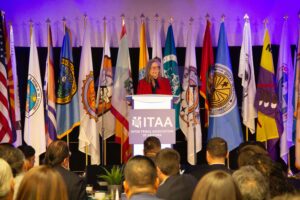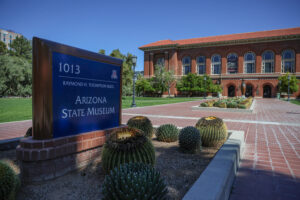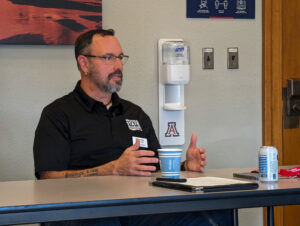- Slug: NAGPRA Hobbs. 700 words.
- Photos, captions available below.
By Mackenzie Miller, Matthew Bird and Justin Patton
Cronkite News and the Howard Center for Investigative Journalism at ASU
PHOENIX – The mood at the Arizona State Museum at the University of Arizona in Tucson on Wednesday was shock.
The museum’s staff, who facilitate the repatriation of Native American human remains and artifacts to Indigenous tribes, learned that Gov. Katie Hobbs was seeking $7 million to aid their efforts.
That mood quickly shifted to excitement.
“If that money comes to us … that will allow us to move forward,” said James Watson, the museum’s associate director who oversees repatriation work.
Arizona State Museum, or ASM, houses the state’s largest collection of human remains eligible for repatriation to tribes under federal law, but for years has been seeking more staff and more space for the work.
Speaking at her annual Tribal State of the State address last week, Hobbs told representatives of Arizona’s 22 federally recognized tribes that her budget request will speed up ASM’s efforts.
“The hardworking staff at the museum have done their best to repatriate human remains and artifacts to tribes without any significant financial investment from the state,” Hobbs said. “It is time for that to change. It is time for the state to take repatriation seriously.”
The Native American Graves Protection and Repatriation Act of 1990 requires museums and other institutions to identify human remains and cultural artifacts in their collections and make them available to tribes for repatriation.
However, an investigation last year by Cronkite News and the Howard Center for Investigative Journalism found that ASM had failed to meet the repatriation timelines set out in the law, in part because the university system had not adequately funded the work, or provided enough space for the time-consuming process of identifying human remains and artifacts.
The governor’s office said the investigation by Cronkite News and the Howard Center helped bring Hobbs’ attention to this issue.
“The reporting has undoubtedly helped to shine a light on these important issues,” said Liliana Soto, the governor’s press secretary.
ASM had previously said that completing the repatriation of ancestors and artifacts in its collections would take until 2030. However, in a phone call with the Howard Center last week, Watson said more money would allow the museum to hire additional, necessary staff, and could shorten the museum’s repatriation timeline by at least two years.
“We can hire more people to work on repatriation and help associate projects, but that doesn’t solve the issue that we have with space,” Watson said. “[The funding] could certainly help us attain our goals sooner, and I think that’s what’s most important.”
As of April 2024, ASM previously made available about half of the human remains in their collection for repatriation.
The governor’s office said Hobbs is committed to addressing the challenges faced by ASM and helping them to become compliant with NAGPRA.
“Gov. Hobbs recognizes how critical this allocation is for ASM, the state’s archeological repository, as they have faced funding shortages that have delayed repatriation efforts,” Soto said.
Lawmakers are set to vote on the budget by the end of June. If passed, the funds could come as soon as July 1.
Cronkite News and the Howard Center also investigated repatriation efforts at Arizona State University, which holds the state’s second largest collection of remains and artifacts, and found the university also faced staffing and space crunches that impeded repatriation.
The June 2024 report revealed that since NAGPRA’s enactment in 1990, ASU had made available to tribes fewer than 2% of its collection of items. That rate put ASU in the bottom quarter of institutions nationally.
A spokesperson for Hobbs did not answer a question about whether the governor would request additional funding to speed repatriation efforts at ASU.
On Friday, Cronkite News and the Howard Center asked ASU for comment about its recent repatriation work. The university did not provide any updates.
An ASU spokesman, however, walked back statements appearing last week in a report from Capitol Media Services suggesting ASU disputed the 2% figure from the Cronkite News/Howard Center investigation. ASU officials had confirmed the same figure to Cronkite News and the Howard Center in June.
On Friday, when asked about what was in dispute, an ASU spokesman said his office had contributed to a misunderstanding about the matter.
For more stories from Cronkite News, visit cronkitenews.azpbs.org.


